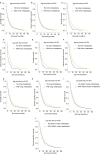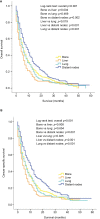Prognostic value of site-specific metastases and therapeutic roles of surgery for patients with metastatic bladder cancer: a population-based study
- PMID: 29180897
- PMCID: PMC5694197
- DOI: 10.2147/CMAR.S148856
Prognostic value of site-specific metastases and therapeutic roles of surgery for patients with metastatic bladder cancer: a population-based study
Abstract
Background: We aimed to evaluate the prognostic value of site-specific metastases in patients with metastatic bladder cancer and analyze the roles that surgeries play in the treatment of this malignancy.
Materials and methods: A population-based retrospective study using Surveillance, Epidemiology and End Results dataset was performed and metastatic bladder cancer patients were classified according to the sites of metastases (bone, brain, liver, lung and distant lymph nodes). Kaplan-Meier analysis with log-rank test was used for survival comparisons. Multivariate Cox regression model was employed to analyze the effect of distant metastatic sites on overall survival (OS) and cancer-specific survival (CSS).
Results: A total of 1862 patients with metastatic bladder cancer from 2010 to 2014 were identified. Bone, lung and distant lymph nodes were the most common metastatic sites. Patients with bone, brain, liver and lung involvement had worse OS and CSS compared to patients without the corresponding sites of metastases. Multivariate analysis showed that bone, brain, liver and lung metastases were independent prognostic factors for both OS and CSS, while distant node metastasis was not. Moreover, patients with a single metastatic site had more favorable OS (p<0.001) and CSS (p<0.001) than patients with multisite metastases. Among single-site metastatic patients, distant nodes and liver metastases represented the best and the worst prognosis, respectively. Moreover, radical cystectomy was an independent predictor for better OS and CSS, while in patients with liver metastasis and multiple metastatic sites, RC did not bring benefits. Besides, in patients with a single metastatic site, metastasectomy seemed to be associated with favorable OS (p=0.042), especially for patients with age <65 years (p=0.006) and for muscle-invasive bladder cancer patients (p=0.031).
Conclusion: Distant metastatic sites have differential impact on survival outcomes in patients with metastatic bladder cancer. Surgeries, including radical cystectomy and metastasectomy, might still lead to survival benefits for highly selected patients.
Keywords: Epidemiology and End Results; Surveillance; bladder cancer; metastasectomy; metastatic site; prognosis; radical cystectomy.
Conflict of interest statement
Disclosure The authors report no conflicts of interest in this work.
Figures







Similar articles
-
Prognostic Value of Site-Specific Metastases and Therapeutic Roles of Surgery and Chemotherapy for Patients With Metastatic Renal Pelvis Cancer: A SEER Based Study.Technol Cancer Res Treat. 2021 Jan-Dec;20:15330338211004914. doi: 10.1177/15330338211004914. Technol Cancer Res Treat. 2021. PMID: 33929915 Free PMC article.
-
Prognostic Significance of Organ-Specific Metastases in Patients with Metastatic Upper Tract Urothelial Carcinoma.J Clin Med. 2022 Sep 9;11(18):5310. doi: 10.3390/jcm11185310. J Clin Med. 2022. PMID: 36142956 Free PMC article.
-
Prognosis of Patients With Testicular Carcinoma Is Dependent on Metastatic Site.Front Oncol. 2020 Jan 10;9:1495. doi: 10.3389/fonc.2019.01495. eCollection 2019. Front Oncol. 2020. PMID: 31998648 Free PMC article.
-
Is There a Role for Surgery in the Treatment of Metastatic Urothelial Carcinoma?J Clin Med. 2024 Dec 10;13(24):7498. doi: 10.3390/jcm13247498. J Clin Med. 2024. PMID: 39768421 Free PMC article. Review.
-
Lung-Seeking Metastases.Cancers (Basel). 2019 Jul 19;11(7):1010. doi: 10.3390/cancers11071010. Cancers (Basel). 2019. PMID: 31330946 Free PMC article. Review.
Cited by
-
The role of surgery on primary site in metastatic upper urinary tract urothelial carcinoma and a nomogram for predicting the survival of patients with metastatic upper urinary tract urothelial carcinoma.Cancer Med. 2021 Nov;10(22):8079-8090. doi: 10.1002/cam4.4327. Epub 2021 Oct 14. Cancer Med. 2021. PMID: 34647688 Free PMC article.
-
How do organ-specific metastases affect prognosis and surgical treatment for patients with metastatic upper tract urothelial carcinoma: first evidence from population based data.Clin Exp Metastasis. 2017 Dec;34(8):467-477. doi: 10.1007/s10585-018-9884-z. Epub 2018 Mar 2. Clin Exp Metastasis. 2017. PMID: 29500709
-
Marital Status and Prognostic Nomogram for Bladder Cancer With Distant Metastasis: A SEER-Based Study.Front Oncol. 2020 Oct 27;10:586458. doi: 10.3389/fonc.2020.586458. eCollection 2020. Front Oncol. 2020. PMID: 33194738 Free PMC article.
-
Liver metastases and the efficacy of the PD-1 or PD-L1 inhibitors in cancer: a meta-analysis of randomized controlled trials.Oncoimmunology. 2020 Apr 9;9(1):1746113. doi: 10.1080/2162402X.2020.1746113. eCollection 2020. Oncoimmunology. 2020. PMID: 32313724 Free PMC article.
-
Efficacy of immune checkpoint inhibitor therapy for advanced urothelial carcinoma in real-life clinical practice: results of a multicentric, retrospective study.Sci Rep. 2023 Oct 13;13(1):17378. doi: 10.1038/s41598-023-44103-9. Sci Rep. 2023. PMID: 37833455 Free PMC article.
References
-
- Siegel RL, Miller KD, Jemal A. Cancer statistics, 2016. CA Cancer J Clin. 2016;66(1):7–30. - PubMed
-
- Ferlay J, Soerjomataram I, Dikshit R, et al. Cancer incidence and mortality worldwide: sources, methods and major patterns in GLOBOCAN 2012. Int J Cancer. 2015;136(5):E359–E386. - PubMed
-
- Pruthi RS, Baldwin N, Bhalani V, Wallen EM. Conservative management of low risk superficial bladder tumors. J Urol. 2008;179(1):87–90. discussion 90. - PubMed
-
- Witjes JA, Compérat E, Cowan NC, et al. EAU- ESTRO-ESUR-SIOG Guidelines. Arnhem: EAU Guidelines Office; 2017. Muscle-invasive and metastatic bladder cancer; pp. 9–10.
LinkOut - more resources
Full Text Sources
Other Literature Sources
Medical

